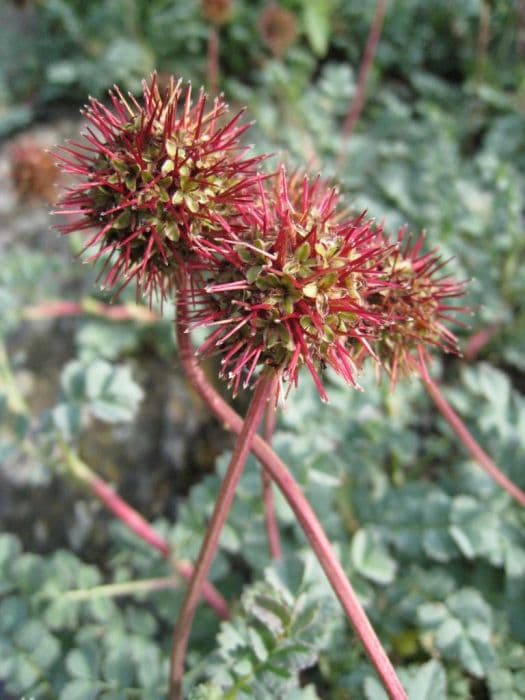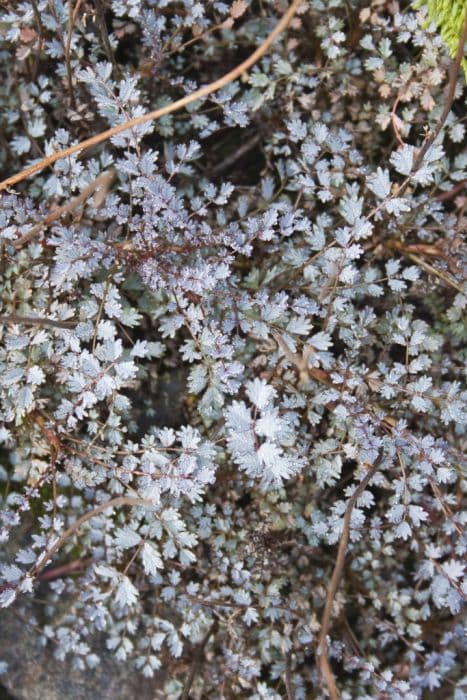Cheal's Weeping Cherry Prunus 'Kiku-shidare-zakura'

ABOUT
The Prunus 'Kiku-shidare-zakura', commonly known as the Cheal's Weeping Cherry, is a visually captivating ornamental tree that is adored for its distinctive weeping form. The branches of this tree cascade downward, creating a dramatic, fountain-like profile that is both elegant and striking. In spring, the tree comes alive with an abundance of pink, double flowers that generously cover the drooping branches. These blossoms are notably plush and resemble fluffy pom-poms, which adds to the tree's charm and visual appeal. The flowers of the Cheal's Weeping Cherry are characteristically deep pink in bud, becoming paler as they open fully, eventually turning into a soft pink or almost white. This gradation of color creates a romantic and enchanting effect, making the tree a focal point in any garden during its blooming period. The foliage that follows the floral display is also attractive; green leaves emerge, with an ovate shape and a serrated edge. In autumn, the leaves may change to warm hues, providing seasonal interest. Overall, the Cheal's Weeping Cherry offers a stunning exhibition of both floral and foliage beauty that can bring a sense of elegance and spectacle to any landscape where it is planted. Its weeping habit and copious flowering create an air of grace and have made it a popular choice for gardens around the world.
About this plant
 Names
NamesFamily
Rosaceae
Synonyms
Cheal's Weeping Cherry, Kiku-shidare Sakura, Weeping Sakura, Japanese Weeping Cherry
Common names
Prunus 'Kiku-shidare-zakura'.
 Toxicity
ToxicityTo humans
The most common common name for Prunus 'Kiku-shidare-zakura' is Cheal's Weeping Cherry. Like many other members of the Prunus genus, parts of the Cheal's Weeping Cherry are considered toxic to humans due to the presence of compounds known as cyanogenic glycosides, which can release cyanide when ingested. These compounds are mainly found in the seeds, leaves, and stems of the plant. If ingested in significant quantities, symptoms of cyanide poisoning may include headache, dizziness, confusion, nausea, difficulty breathing, and increased heart rate. In severe cases, ingestion can lead to poisoning which might be fatal.
To pets
Cheal's Weeping Cherry is also toxic to pets, such as dogs and cats. The plant contains cyanogenic glycosides, especially in the seeds, leaves, and stems. If pets ingest parts of the plant, they could also experience symptoms of cyanide poisoning. These symptoms may include vomiting, diarrhea, abdominal pain, difficulty breathing, and lethargy. In serious cases, ingestion can lead to potential seizures, coma, or even death, particularly if not treated promptly. Owners should prevent pets from chewing on or ingesting any part of the Cheal's Weeping Cherry plant.
 Characteristics
CharacteristicsLife cycle
Perennials
Foliage type
Deciduous
Color of leaves
Green
Flower color
Pink
Height
8 feet (2.4 meters)
Spread
8 feet (2.4 meters)
Plant type
Tree
Hardiness zones
5
Native area
Asia
Benefits
 General Benefits
General Benefits- Aesthetic Appeal: Adds beauty to landscapes with its cascading branches and pink blooms.
- Seasonal Interest: Offers a stunning floral display in spring, adding seasonal charm.
- Shade Provider: Creates a cool, shaded area beneath its canopy during warmer months.
- Habitat for Wildlife: Attracts pollinators like bees and butterflies, supporting biodiversity.
- Compact Size: Suitable for small gardens due to its relatively small stature.
- Urban Tolerant: Can thrive in urban environments, tolerating pollution and confined spaces.
- Low Maintenance: Requires minimal pruning and care once established.
- Emotional Wellbeing: Enhances mood and provides relaxation with its graceful appearance.
- Cultural Significance: Often associated with traditional celebrations and practices in Japan.
 Medical Properties
Medical PropertiesThis plant is not used for medical purposes.
 Air-purifying Qualities
Air-purifying QualitiesThis plant is not specifically known for air purifying qualities.
 Other Uses
Other Uses- Prunus 'Kiku-shidare-zakura', commonly known as Cheal's Weeping Cherry, can be used as a bonsai specimen due to its elegant weeping form, providing a miniature version of the tree for enthusiasts.
- The wood of Cheal's Weeping Cherry can be used in woodworking and crafting, particularly in making small decorative items or ornamental projects where its grain can be appreciated.
- During blooming season, the blossoms of the tree can be used in photography as a stunning natural backdrop for portraits, weddings, and other outdoor photography sessions.
- The fallen blossoms can be used in art projects, such as pressing them for inclusion in paper making or botanical prints.
- Due to its distinct shape and ornamental look, branches of the Cheal's Weeping Cherry can be used in floral arrangements and centerpieces, especially during springtime events.
- The tree can be planted in memory gardens or as a living memorial tribute because it symbolizes the fleeting nature of life with its ephemeral blossoms.
- Cheal's Weeping Cherry can be used for creating natural dye, where the blossoms provide shades of pink and other subtle hues for fabrics and yarns.
- In the culinary arts, the petals and blossoms can sometimes be candied or used as edible decorations for desserts and pastries, adding a touch of elegance.
- The tree's canopy can provide a natural habitat or nesting place for birds, beneficial insects, and small wildlife, contributing to local biodiversity.
- Cheal's Weeping Cherry trees can be used as a living fence or privacy screen when planted in a row, offering a beautiful and natural boundary for properties.
Interesting Facts
 Feng Shui
Feng ShuiThe Weeping Cherry is not used in Feng Shui practice.
 Zodiac Sign Compitability
Zodiac Sign CompitabilityThe Weeping Cherry is not used in astrology practice.
 Plant Symbolism
Plant Symbolism- Beauty and Life: The 'Cheal's Weeping Cherry', known for its striking cascades of pink flowers, commonly symbolizes the transient nature of life and beauty, echoing the traditional Japanese appreciation for fleeting beauty reflected in centuries-old cherry blossom festivals.
- Elegance and Grace: Its graceful weeping form and delicate blossoms also embody elegance and grace, representing the aesthetic value and refinement found in nature.
- Renewal and Optimism: The flowering of 'Cheal's Weeping Cherry', which occurs in spring, heralds the end of winter and is often interpreted as a sign of renewal and new beginnings, fostering a sense of optimism and rejuvenation.
- Femininity and Love: With its soft, pink-hued blossoms, the tree is often associated with femininity and can symbolize love, particularly in Japanese culture where cherry blossoms hold significant meaning in love and romance.
- Impermanence: The fleeting bloom period of the cherry blossoms serves as a reminder of life's impermanence, encouraging mindfulness and the cherishing of every moment, aligning with the Buddhist concept of 'mono no aware', the awareness of impermanence.
 Water
WaterThe weeping cherry, commonly called the Cheal's Weeping Cherry, needs deep and thorough watering to encourage deep root growth, particularly during dry spells. During the growing season, it's crucial to maintain consistent moisture, so watering every 7 to 10 days is recommended, providing about 1.5 to 2.5 gallons per session depending on the size and maturity of the tree and soil conditions. Water slowly at the base of the tree, allowing the water to infiltrate the soil and reach the roots without running off. In winter, reduce watering frequency, but do not let the tree dry out completely.
 Light
LightThe weeping cherry thrives in a spot that receives full sun for at least six hours a day. It prefers a well-lit location to encourage the best flowering and healthy growth. Avoid placing it in deep shade as this can reduce bloom intensity and possibly affect the overall health of the tree.
 Temperature
TemperatureThe weeping cherry is hardy and beneficial in a climate with seasonal temperature variation, doing well in the range of 20°F to 85°F. It can survive brief temperature drops down to about -20°F but extended periods of extreme cold may harm it. Ideal growing temperatures are moderate, between 50°F and 70°F.
 Pruning
PruningPruning the weeping cherry is important to maintain its shape, remove dead or crossed branches, and encourage healthy growth. Prune in late winter or early spring before the tree starts to blossom. Cut back branches to just above a set of leaves or to a natural break to promote a weeping habit. Pruning should be done annually or as needed to keep the tree looking its best.
 Cleaning
CleaningAs needed
 Soil
SoilThe Cheals Weeping Cherry thrives in well-draining soil with a pH of 6.0 to 7.5. A mix of loam, compost, and akadama (a type of Japanese volcanic clay soil) is ideal to ensure good drainage and fertility.
 Repotting
RepottingThe Cheals Weeping Cherry, being a larger specimen, is not typically repotted. Instead, it is planted in the ground where it does not require repotting.
 Humidity & Misting
Humidity & MistingCheals Weeping Cherry prefers average outdoor humidity levels; it does not have specific humidity requirements for healthy growth.
 Suitable locations
Suitable locationsIndoor
Not ideal indoors; requires full sun, large space, periodic pruning.
Outdoor
Plant in full sun, well-draining soil; accommodate ample growth space.
Hardiness zone
5-8 USDA
 Life cycle
Life cycle'Kiku-shidare-zakura', commonly known as the Cheals Weeping Cherry, begins its life with seed germination, which occurs when conditions of moisture and temperature are favorable, usually in spring. The seed develops into a seedling, which grows actively during the warmer months, establishing a root system and foliage. As it matures into a sapling, the tree experiences vegetative growth, forming a distinctive weeping shape. The Cheals Weeping Cherry reaches reproductive maturity within a few years, at which point it begins to bloom annually with a spectacular display of pink flowers in the spring. After the flowering stage, the tree produces small fruit which contain seeds, completing its reproductive cycle. Over the years, the tree will enter a period of decline where growth slows and, eventually, the tree dies, at which point it decomposes and returns nutrients to the soil.
 Propogation
PropogationPropogation time
Spring-early summer
The most popular method of propagation for the Prunus 'Kiku-shidare-zakura', commonly known as Cheal's Weeping Cherry, is through grafting. Grafting involves joining a stem piece from the desired tree, known as a scion, to a rootstock of another tree, typically of a similar or compatible genus that provides robust roots. This is typically done in late winter or early spring before the buds break. The scion, usually 4 to 6 inches long (10 to 15 centimeters), is cut at a sharp angle and inserted into a corresponding cut in the rootstock. The two pieces are then bound tightly together and sealed with grafting wax or tape to protect the joint and prevent dehydration while the graft heals. Grafting allows for the exact genetic replication of Cheal's Weeping Cherry and ensures that the desirable weeping habit of the tree is preserved.









